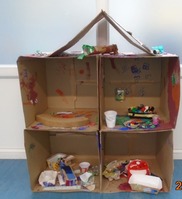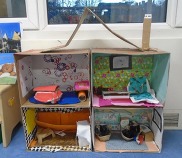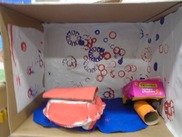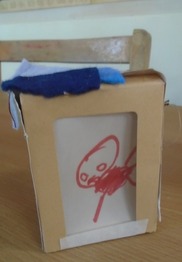|
In 2019 I created an interactive art installation ‘The Home that we Build’ for 5-8 year olds to provoke conversations between children and their guardians about what home looks and feels like as part of my MSc Creative Arts and Mental Health. The installation’s centrepiece was a large cardboard doll’s house that audience members were invited to collaboratively create ‘the perfect home’. Around the room were various playful sensory activities to engage with, to prompt discussion of what home looked, sounded, smelt and felt like to different people. My work was originally inspired by reflecting on loneliness and family dynamics which led me to La Baracca - Testoni Ragazzi’s Families (2019), a children’s theatre piece exploring family models using mannequins. The piece prompts questions such as, ‘What is a family?’ and ‘Is family having children?’ while leaving the answers open. This led me to reflect on the ways in which we identify and position ourselves in relation to ‘things’, both physical and metaphorical, and to settle on the concept of what makes the place we live our ‘home’.

I now teach at Margaret McMillan Nursery School in Islington, and have adapted my house project to work in my classroom with 3 and 4 year olds. I use collaborative box modelling to provoke discussion about what is important to the children about their homes. This seems particularly significant for our youngest children who, given their age and the recent pandemic, have experienced a large percentage of their lives at home.
Susan Clayton, an environmental psychologist at the College of Wooster USA, says that for many people, their home is part of their self-definition, which is why we do things like decorate our houses and take care of the area around our homes. The word ‘home’ will mean different things to different people, both positive and negative, and most importantly it is not specifically tied to a fixed address or particular building. Children are still at a point in their lives where they are trying to work out what they are and what they’re not. Connections to home have a role in this and play related to home can give a safe space to explore these ideas and discover similarities and differences. It is a clear way to demonstrate and hold on to who they are.
Caine’s Arcade (2012) was a big inspiration for the aesthetic and process for the piece. In this short documentary, nine-year-old Caine makes his own arcade out of cardboard and patiently waits for customers. I use cardboard boxes; slightly more shallow ones work best as they’re easier to reach into while playing, and the flaps of the boxes form a roof.
|

I start them off with a traditional ‘doll’s house’ look to introduce the idea but make sure to display pictures of lots of different types of homes to provoke discussion of different places and to reflect the children’s reality. I use photos from the local area for familiarity and ones that are less familiar such as a cottage or a canal boat. I fix the boxes together with cable ties making them sturdy and less fragile than tape or gluing. I provide different materials to stick incorporating varied textures and colours (scraps of fabric, tissue paper, corrugated cardboard, bits of wallpaper). We have also used cutter printing to make our own wallpaper. Small pieces of paper enable the children who want to draw artwork for the walls. Printed photos of bricks/wood/straw might be stuck on the outside or Lego bricks dipped in paint to print.
|

The children are invited to make furniture and accessories. I pose the question ‘What is important in the home?’ This helps draw out what matters to them rather than simply providing a list of furniture. For example, one child replied ‘Black fluffy things’. Once she’d explained what they looked like and where in the house she’d like them, we were able to name them as cushions. It is worth noting that for many children what is of primary importance may be a family member or a particular relationship before considerations of physical space. Having scope to do anything they’d like design wise prompted one child to focus for an extended period, making a tree to go onto the roof of the house after looking at photos of a tree house. For the remainder of the time the house was available, he would bring peers and adults to show them the tree and tell them about it.
|

Another child copied the TV we had previously made for the home corner, choosing a box where pictures she drew of her favourite shows could be slotted in and out. Once the house is complete, we make lollistick puppets of who the children would like in it including themselves, their family members and characters from books. We add the completed doll’s house to the small world area where children continue to add and adapt what they have made.
The conversations that arise out of this activity are, for me, a significant part of its worth. The children co-construct meaning through their use of the materials but also in their use of language for varied functions: naming, comparing, describing, problem solving. In the first cardboard home I built with children in a nursery in Deptford, the children stuck down grass inside so they could walk on grass in the living room. Once finished, one child became frustrated that she could not get inside, another child quickly drew on a piece of paper and stuck it to the floor of the house explaining ‘You walk here and get smaller, so we fit’. The children then all crouched and walked around the house pretending to be inside. The same group shared a realisation that they all had a fridge in their house, excitedly discussing what was inside theirs. Letting the project be led by what is important to the children allows for these discoveries and moments of problem solving to take place while creating a shared home they are proud of.
|
|